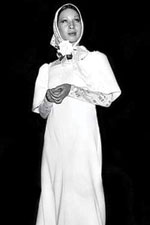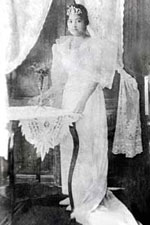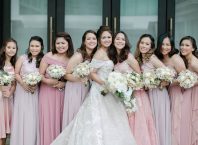The terno should be distinguished from such other Filipino dresses as the informal balintawak and the patadyong. Lacking the terno’s svelte sophistication, these rural costumes are worn mainly by barefoot dancers of the tinikling and by carabao-riding maidens in the landscapes of Amorsolo. The terno, on the other hand, goes with the stately grace of the rigodon de honor, flores de mayo processions, coronation nights and the Malacañang Palace.
The terno, as we know it today, evolved from an ensemble called baro’t saya (blouse and skirt). Traditionally, it consisted of four parts — the camisa (a short blouse with sleeves), the alampay or pañuelo (a type of shawl worn over the camisa), the saya (a long skirt) and the tapis (a short overskirt wrapped around the saya).
Contrary to the observations of foreigners during the last century, the veil was not an intrinsic part of the native dress. It was worn only to church, but since our female ancestors were a pious lot, they were often seen with their heads covered. The church-going colegiala of the 18th century wore a thick baro’t saya with long narrow sleeves, a shroud-like veil and an estampita (saint’s picture) hanging from her neck to deliver her from evil. By the 1750’s, the colegiala’s mother was wearing a large cape-like pañuelo and a wide floor-length saya.
At the start of the 19th century, the terno had acquired the features that were to distinguish it until the end of the colonial era. In 1803, Fr. Joaquin Martinez de Zuñiga noted that the Tagalog women wore “a kind of little shift, which scarcely reaches the navel.” He described the alampay as a “handkerchief loosely covering the neck” and the saya as a “white linen cloth (which) encircle the body and is fastened by a button at the waist. They throw over this a colored stuff, manufactured by the inhabitants of Panay” — undoubtedly the tapis. “Over all is worn a mantle, for the most part black, which covers the body from head to foot” — probably the view from the confessional.

Bagong Anyo ’72
The Balintawak is adapted to a wedding gown worn by Techie Ismael for Christian Espiritu. A “bandana” tied-up with a white rose served as the headdress. Underneath the narrow bell-shaped sleeves are long hugging sleeves of the same materials as the “bandana.” This bridal number is adapted from the balintawak worn by women when they work in the fields. They wear underneath their dresses long-sleeved shirts to protect them from the sun.
Photo taken at Rizal Park, Manila

An all-white terno features a long train with slightly scalloped edge. The basic sheath would evolve into a more clinging skirt at the waist and hip area in the next area.
Photo from Evolution of the Terno. A Project of the Cultural Center of the Philippines. 1991 (No. 62)
. . . . . . . . . . . . . . . . . . . . . . . . . . . . . . . . . . . . . . . . . . . . . . . . . . . . . . . . . . . . . . . . . . . . . . .
Source:
Roces, Alfredo. (Ed). (1978). “The Ins and Outs of the Terno,” Filipino Heritage: the Making of a Filipino Nation Vol. 10, pp. 2536-2541.




